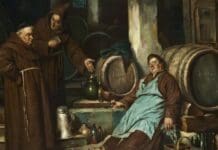Once upon a time, in the misty and mysterious land of the North Atlantic, there lived a small and unusual bird. With its distinctive black and white plumage, bright orange beak, and comical waddling gait, the puffin was a beloved and well-known creature among the fishermen and villagers who lived along the rugged coast.
But where did this peculiar bird get its unusual name? Well, it just so happens that the puffin’s name has a fascinating history, rooted in the traditions and beliefs of medieval Catholicism.
According to legend, the puffin was named after the Dominican monks who inhabited the remote and windswept islands off the coast of Europe. Known as the “Black Monks” or “Black Friars,” these holy men were renowned for their humble and ascetic way of life, as well as their devotion to God and the Church.
But it wasn’t just their monastic habits that earned them their nickname. The Black Monks were also known for their distinctive clothing, which consisted of a black robe, or “cappa,” that covered their entire body, as well as a hood, or “cuculla,” that covered their head and face.
As the story goes, the puffin was named after these Black Monks due to its own striking black and white plumage, which bore a resemblance to the monks’ distinctive robes. The puffin’s bright orange beak, meanwhile, was said to be inspired by the glowing embers of the monks’ fires, which they used to keep warm during the long and freezing winter nights.
But the puffin’s association with the Black Monks went beyond just its appearance. The bird was also said to embody the monks’ hardworking and diligent nature, as it spent most of its days fishing and hunting for food to feed its young.
In addition, the puffin was revered for its bravery and tenacity, as it was known to brave the rough and turbulent seas in search of food, and even to dive deep beneath the waves to catch its prey. This made it a fitting symbol of the Black Monks’ own steadfast faith and devotion, which sustained them through even the darkest and most difficult of times.
For these reasons, the French zoologist Mathurin Jacques Brisson introduced the genus Fratercula in 1760, which includes the Atlantic puffin (Fratercula arctica) as the type species. The name Fratercula comes from the Latin word “friar,” or “little brother.”
So, there you have it: the story of how the puffin came to be named after the Black Monks of the North Atlantic. A quirky and unlikely tale, to be sure, but one that speaks to the enduring power of tradition and the enduring bond between humans and the natural world. And who knows? Maybe, if you’re lucky, you’ll even spot a puffin or two on your next visit to the coast, and you’ll be able to appreciate the fascinating history behind this beloved and enduring symbol of faith and fortitude.

















